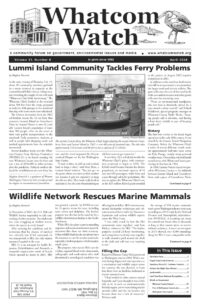by Joe Meche
Similar in many ways to the annual Audubon Christmas Bird Count (CBC), the Puget Sound Seabird Survey (PSSS) is yet another example of citizen science at work. Volunteers take to the field at designated locations to monitor bird populations across a wide swath of northwestern Washington. While the CBC is a one-day effort in all locations, the PSSS is a seven-month survey that provides a broader picture of bird numbers and movements over a longer span of time. Consistency and continuity are key factors in the observation process.
The PSSS was created by Seattle Audubon in 2007 and has been continued by the Puget Sound Bird Observatory (PSBO) since 2022. Like the CBC, this survey gathers valuable information on wintering seabirds in Puget Sound, the Strait of Juan de Fuca, and in the waters surrounding the San Juan Islands. In this broad area of study, population dynamics and densities are recorded in over 5,400 acres of sheltered bays as well as on open water and shoreline habitats. Along with geese, swans, dabbling and diving ducks, loons, grebes, cormorants, gulls, and terns, all seabirds are counted and separated utilizing specific protocol by trained and knowledgeable observers.
The surveys take place at 175 beaches and shorelines across the southern Salish Sea. For consistency, all surveys are synchronized to take place on the first Saturday of the month, from October to April. Likewise, all surveys are conducted in a four-hour window around the highest daytime tide. Additional factors that might affect bird numbers are also recorded, such as human activities occurring within the survey areas. Dog walkers present a challenge as do boaters and birds of prey. Eagles and falcons are especially active as the number of prey species in any given area increases. Observers are also asked to report any signs of pollution and especially oil spills.
After all the fieldwork has been completed for the day and you’re back to the warm and cozy confines of home, the data is entered onto the survey’s interactive website. This season represents my sixth year of participation, and, since I began I’ve conducted 98 surveys and counted over 5,000 individual birds, including most of the birds listed on the working checklists that are provided. I have been assigned three areas of responsibility and all three are on the Semiahmoo Spit … my home away from home. Like the CBC, these surveys continue regardless of weather conditions, which are recorded as well. The only time weather plays a role is if it affects the observer’s ability to actually see and record the birds.
On my most recent survey in early January, the effect of weather on survey day was never more clearly on display. The high tide teamed with the unexpectedly strong northwest wind to make viewing very difficult. From one of my observation points on the floating dock at the end of the spit, three to four foot swells made for up and down movements for me, as well as for the birds I was attempting to identify and log in to my record sheets. The same conditions prevailed on the bay side of the spit; although, at my third station, conditions were perfectly calm! But then, there was no rain to report and it was a beautiful day.
______________________
Joe Meche is a past president of the North Cascades Audubon Society and was a member of the board of directors for 20 years. He has been watching birds for more than 60 years and photographing birds and landscapes for more than 40 years.




























